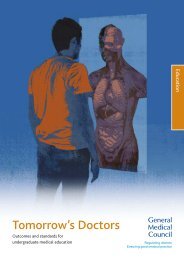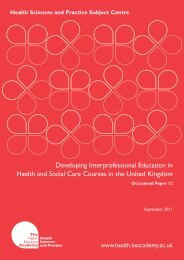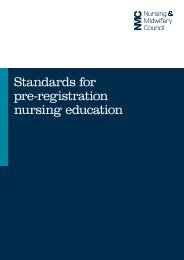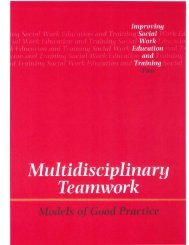- Page 1 and 2: Patient Safety Curriculum Guide Mul
- Page 3 and 4: WHO Library Cataloguing-in-Publicat
- Page 5 and 6: Part B: Curriculum Guide Topics Def
- Page 8 and 9: Patient Safety Curriculum Guide: Mu
- Page 10 and 11: World Health Organization Commitmen
- Page 12 and 13: International Pharmaceutical Federa
- Page 16 and 17: International Association of Dental
- Page 18 and 19: Meeting the needs of our future hea
- Page 20: Topic 4: Being an effective team pl
- Page 23 and 24: 1. Background Why do health-care st
- Page 25 and 26: 4. Johnstone MJ, Kanitsake O. Clini
- Page 27 and 28: Australian Patient Safety Education
- Page 29 and 30: to the degree of responsibility of
- Page 31 and 32: When students think in terms of ‘
- Page 33 and 34: undertaken in many countries, which
- Page 35 and 36: 3. Aims of the Curriculum Guide The
- Page 37 and 38: 4. Structure of the Curriculum Guid
- Page 39 and 40: How to review your curriculum for p
- Page 41 and 42: knowledge), psychology (behavioural
- Page 43 and 44: Box A.6.2. Linking patient safety e
- Page 45 and 46: How are individual curriculum topic
- Page 47 and 48: Chart A.6.4. Implementation of pati
- Page 49 and 50: Case example: the case may include
- Page 51 and 52: topic is relevant to patient safety
- Page 53 and 54: Give students the opportunity to ap
- Page 55 and 56: member in the workplace. It is help
- Page 57 and 58: 8. Activities to assist patient saf
- Page 59 and 60: from all members of society-patient
- Page 61 and 62: Tools and resource material Bingham
- Page 63 and 64: the students’ accounts completing
- Page 65 and 66:
knowing what might be assessed. Fac
- Page 67 and 68:
Objective structured clinical exami
- Page 69 and 70:
Tools and resource material Newble
- Page 71 and 72:
Table A.10.1. Examples of stakehold
- Page 73 and 74:
ehaviour [4]. If you are interested
- Page 75 and 76:
11. Web-based tools and resources E
- Page 77:
The old style of curriculum emphasi
- Page 81 and 82:
Definitions of Key Concepts The WHO
- Page 83 and 84:
Key to Icons Slide number 1 Topic n
- Page 85 and 86:
managers, cleaners and catering sta
- Page 87 and 88:
Health-care workers want to maintai
- Page 89 and 90:
organizations, openness about error
- Page 91 and 92:
Infallibility of health-care profes
- Page 93 and 94:
Topic 1 What is patient safety? Car
- Page 95 and 96:
Introduction-Why is patient 1 safet
- Page 97 and 98:
lost income, disability and medical
- Page 99 and 100:
An analysis of the Chernobyl catast
- Page 101 and 102:
that errors are unacceptable and th
- Page 103 and 104:
designed a simple model of patient
- Page 105 and 106:
the patients they are allowed to tr
- Page 107 and 108:
could have been prevented and steps
- Page 109 and 110:
The assessment of knowledge of the
- Page 111 and 112:
Slides for Topic 1: What is patient
- Page 113 and 114:
Box B.2.1 below, published by the A
- Page 115 and 116:
when they do occur. While we cannot
- Page 117 and 118:
Routinely use checklists The use of
- Page 119 and 120:
ehind the wheel of her car and stru
- Page 121 and 122:
performance impairment. Nature, 199
- Page 123 and 124:
Keywords System, complex system, hi
- Page 125 and 126:
Wu described the health-care worker
- Page 127 and 128:
their condition or appreciate the i
- Page 129 and 130:
How students can apply this knowled
- Page 131 and 132:
home she collapsed and died. At aut
- Page 133 and 134:
is being considered, it is a good i
- Page 135 and 136:
allied health professionals and war
- Page 137 and 138:
Administration Administration inclu
- Page 139 and 140:
Good cohesion Cohesive teams have a
- Page 141 and 142:
Psychological safety This is the de
- Page 143 and 144:
care interventions for patients, th
- Page 145 and 146:
the staples and sew the incisions.
- Page 147 and 148:
Teaching activities Engaging role m
- Page 149 and 150:
While there is a compelling argumen
- Page 151 and 152:
organisational research. Leicester,
- Page 153 and 154:
and error-causing conditions that i
- Page 155 and 156:
Students are in a privileged positi
- Page 157 and 158:
has been paid to the importance of
- Page 159 and 160:
ñ Avoid reliance on memory ñ Simp
- Page 161 and 162:
The surgical resident helped the pa
- Page 163 and 164:
Topic 6 Understanding & managing cl
- Page 165 and 166:
ñ know how to report risks or haza
- Page 167 and 168:
categories are referred to as “ot
- Page 169 and 170:
competence. Proper registration/lic
- Page 171 and 172:
How to understand and manage clinic
- Page 173 and 174:
Acknowledgment of a health-care err
- Page 175 and 176:
That night, the patient had to be r
- Page 177 and 178:
Topic 7 Using quality-improvement m
- Page 179 and 180:
The science of improvement 5 The sc
- Page 181 and 182:
1. What are we trying to accomplish
- Page 183 and 184:
In this analogy, the aim of the imp
- Page 185 and 186:
We will return to this example late
- Page 187 and 188:
to use. Many health services, such
- Page 189 and 190:
Figure B.7.6. Example of a Pareto c
- Page 191 and 192:
- develop better study habits; - sp
- Page 193 and 194:
Topic 8 Engaging with patients and
- Page 195 and 196:
Performance requirements 4 Students
- Page 197 and 198:
skills and attitudes that a health-
- Page 199 and 200:
The process of providing an open, c
- Page 201 and 202:
The Harvard Framework for 13 disclo
- Page 203 and 204:
health-care provider. Students shou
- Page 205 and 206:
ñ Ask students to spend a day with
- Page 207 and 208:
gestures and comprehension of the p
- Page 209 and 210:
3. Emmanuel L et al, eds. The patie
- Page 211 and 212:
Topic 9 Infection prevention and co
- Page 213 and 214:
The extent of the problem The urgen
- Page 215 and 216:
devices such as thermometers, other
- Page 217 and 218:
WHO Guidelines on Hand Hygiene in H
- Page 219 and 220:
The WHO Glove Use Information Leafl
- Page 221 and 222:
also have contact with devices or c
- Page 223 and 224:
students could practise techniques
- Page 225 and 226:
Ducel G et al. Prevention of hospit
- Page 227 and 228:
Slides for Topic 9: Infection preve
- Page 229 and 230:
Keywords Surgical and procedural si
- Page 231 and 232:
In this study, 36% of communication
- Page 233 and 234:
educed by more than one third when
- Page 235 and 236:
ñ understand why the protocol/chec
- Page 237 and 238:
Different scenarios could be develo
- Page 239 and 240:
senior and junior surgery trainees.
- Page 241 and 242:
Medical Practice Study II. New Engl
- Page 243 and 244:
Introduction-Why focus 1 2 on medic
- Page 245 and 246:
Manufacturing, distribution and mar
- Page 247 and 248:
and lack of vigilance. A lack of ch
- Page 249 and 250:
emember when communicating about me
- Page 251 and 252:
to what medication he/she is being
- Page 253 and 254:
tachycardia and hypotension. The pa
- Page 255 and 256:
- How might the adverse event been
- Page 257 and 258:
talking about serious medication er
- Page 260 and 261:
Annexes Patient Safety Curriculum G
- Page 262 and 263:
Annex 2 Assessment examples Example
- Page 264 and 265:
Continuing example 3: OSCE station
- Page 266:
Example 4: Short answer questions T
- Page 269 and 270:
Acknowledgements Contributors liste
- Page 271 and 272:
The World Medical Association (WMA)













